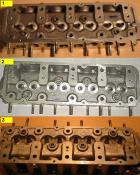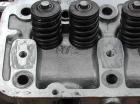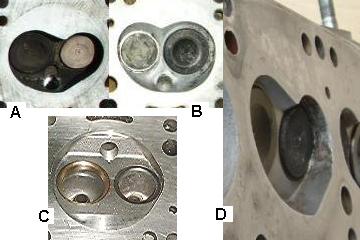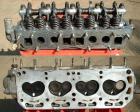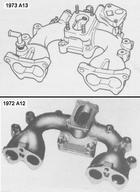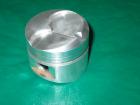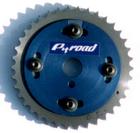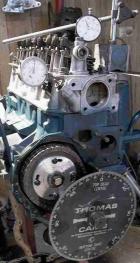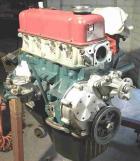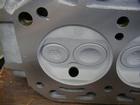| Revision as of 04:40, 25 March 2008 Ddgonzal (Talk | contribs) (->Intake Manifolds) <- Previous diff |
Revision as of 04:49, 25 March 2008 Ddgonzal (Talk | contribs) (->A12 round-port head) Next diff -> |
||
| Line 184: | Line 184: | ||
| The 1967-1973 heads and 1974-up heads provide oil to the rocker armshafts in different locations, so when swapping you may need to redrill the oil passage. | The 1967-1973 heads and 1974-up heads provide oil to the rocker armshafts in different locations, so when swapping you may need to redrill the oil passage. | ||
| + | |||
| + | == A12 round-port High-Compression head == | ||
| + | Same as above, but with closed chamber. Known in SCCA racing circles as the "H Production" head, legal alternative for A12 engine. | ||
| + | |||
| + | [http://datsun1200.com/modules/myalbum/photo.php?lid=15690 http://datsun1200.com/modules/myalbum/photos/15690.jpg] | ||
| + | <br>Photo: 1971-1973 style. | ||
| == A12GX Head == | == A12GX Head == | ||
Revision as of 04:49, 25 March 2008
Nissan A-series Engine cylinder heads are of one type: inline valves, pushrod valve system (non-overhead cam), two-valves per cylinder. The head is non-crossflow meaning that exhaust and intake ports are on the same side (left side).
There was one exception: The race-only AY12 cylinder head:

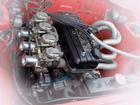
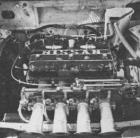
Contents |
Cylinder Head Identification
For the cylinder head, the best way to tell which head you have is to check the casting number in the valve train area (remove the rocker cover to look for this number).
If the head you are looking at does not have a casting number, see the next section: Distinguishing Features.
Once you have the casting number, see Nissan Part Number Prefixes for a table of the different model to part numbers. For example, H23 means the part was originally designed for B110 GX models.
- A10 may have "180", "H01", "257", "H03" or no markings at all
- 1971-1973 A12 may have "180", "H10" or "H39". Some have no markings at all.
- A12 GX may have "H23" or "230"
- 76 Sunny trucks (A12) may have M30, G25, G61
- 1974 A13 may have "H62" or "620"
- A14 could have several different ones, such as G32, H72 (or 728), H74, H75, H77, H78, H85, H92 or H98 depending upon year, country, and emission control design.
- M24 or 246 is A14T (Hitachi Twin Carb engine)
- H85 is A12 or A13 (newer engines)
The casting number will be the first 3 digits of the last half of the part number, as all cylinder head part numbers begin with the same 5 digits (11041). For example:
11041-H2300 or 11041-H2301 HEAD ASSY-CYLINDER A12 GX
- 11041 is the base part number for all cylinder heads
- "H23" means the part was first used on the B110 GX vehicle.
- "728" is short for H728x, indicating a B210 "H72" part
references:
- Nissan Part Number Prefixes
- Discussion: Various cylinder heads
- Discussion: A14 head--728-402
Also see the next section Distinguishing Features.
Distinguishing Features
Any A-type cylinder head will bolt onto any A-type engine. However compression and intake ports are big consideration, as are the manifold bolt patterns. For best results, match port types (e.g. round-port manifold on round-port head). The most critical difference is the rocker shaft oil passage. It is in a different place between early and late engines.
Oil passage in the head
An extra oil passage in the head is needed for some engines.
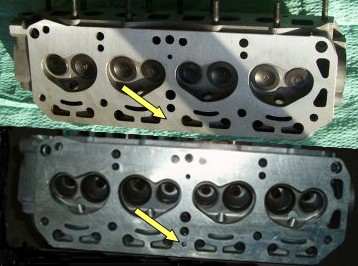
Top: 1974, no passage. Bottom: 1973, has passage.
The old 1967-1973 head has the oil passage:


Boss on outside identifies the head
Compare to newer head: no passage:

The newer engine has the passage in the block instead. The solution for Old engine block, Newer head: drill the passage in the head.
Discussion: question about oil blockage
Combustion Chamber
- A,B: Heart-shaped high-compression chamber is good for high-octane gasoline
- a.k.a: closed chamber, peanut-shaped, butterfly-shaped or kidney-shaped
- C: 360 degree open chamber low-compression is good for regular-octane gasoline</li>
- D: Bathtub chamber (from swirl port head)?
Any combustion chamber design can fit on any A-series engine.
Comparo - Closed Chamber vs. Open Chamber

Intake Ports
- Round: These are best for low-RPM operation
- Small oval (28 mm x 30 mm). The 1974 A13 has this design.
- Large oval (28 mm x 34 mm). These are best for high-RPM operation, or for the bigger engines
- GX oval (30 mm x 36 mm). From A12GX and A12T engines.
Port Sizes
| Ports | Size (mm) | Exhaust | Raised | Note |
| round | 28 | ? * | no | 1971 A12 |
| round | 28 | ? | lowered | 1977 GFU |
| Oval - small | 28x30 | ? * | no | 1973 A13 |
| Oval - large | 28x34 | ? | no | Many A14s |
| Oval - GX | 30x34.5 - 36 | 27x29 | Yes | A12Gx (1971-1973) |
- GX extra-large oval ports (36 mm tall)
Intake Manifolds
All A-series heads will interchange with either type of intake with the following caveats:
- If the intake doesn't have coolant passages, tap the head's coolant ports and install plugs
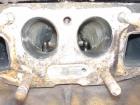
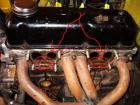 <li>If the intake does, but the head doesn't, cold-weather starting and
cold-idle may suffer due to insufficient heat. However, warm-engine
operation should be OK.
<li>If the intake does, but the head doesn't, cold-weather starting and
cold-idle may suffer due to insufficient heat. However, warm-engine
operation should be OK.
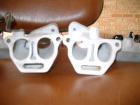
Valve Springs
The following A-series heads had dual valve springs. There is a small-diameter spring inside the main spring.
- A12GX
- A12T
- A14T
- A14E
- Heads retro-fitted with dual springs
So dual springs are a good indication of a special head, but not conclusive. You will need to check the intake port sizes and other features to make a final determination.
Valve sizes
| Valves | Intake PN (13201) | In. Size | Exhaust PN (13202) | Ex. Size |
| A10, early A12, late A12 Van | 13201-H1000 | 35mm | 13202-H18000 | 29mm |
| A12GX/A12T | 13201-H2300 | 35mm | 13202-H2300 | 29mm |
| Late A12, A13, A12AS | 13201-H2300 | 35mm | 13202-H7400 | ? |
| A13(old),A14 & A15 | 13201-H6200 | 37mm | 13202-H6200, H8900 | 30mm |
| A12A, A14, A15 1982 USA | 13201-H9500 | 35mm | 13202-H9500 | 30mm |
| A12A, A14, A15 1982 canada | 13201-H6200 | 37mm | 13202-H6200 | 30mm |
VALVES (A-SERIES)
4 of each required
- 13201-H2300 35MM/1.38" INTAKE VALVE A12, A12GX
- 13201-H6200 37MM/1.46" INTAKE VALVE A14, A15
- 99996-H1100 COMPETITION 37MM/1.46" INTAKE VALVE
- 13202-H2300 29MM/1.14" EXHAUST VALVE A12, A12GX
- 13202-H6200 30MM/1.18" EXHAUST VALVE A14, A15
- 99996-H1110 COMPETITION 30MM/ 1.18" EXHAUST VALVE
Competition Valves are "Polished and tuliped for improved flow characteristics".
Reference: 1984 Nissan Competition catalog
Coolant Passages
Coolant passages are below the intake ports (present or not). If present, they can be large holes or small holes.
- A12GX has small coolant holes
- Other heads have either no coolant holes, large ones, or a mix
Intake/Exhaust manifold bolt pattern
The 1971-1973 A12 differs from the A13/A14/A15 and most A12s after 1973 except wagons.
The bolt pattern on the cylinder heads also differ. A10/A12 heads are only drilled for the older pattern. Some newer heads are drilled for both.
Heads By Engine
A10 head
The 1971 A10 head is 9.0:1, same as the A12 head. Does this mean it has a 20% smaller chamber than the A12? Or are the pistons dished differently? It use 29mm and 35mm valves (same as A12).
A12 round-port head
(1971-1973 Datsun 1200)
Intake: 35mm
Exhaust: 29mm
compression ratio 9.0:1 with dished pistons
A ported and polished standard A12 head with larger valves fitted flows about the same as a standard GX head. Also see
The 1967-1973 heads and 1974-up heads provide oil to the rocker armshafts in different locations, so when swapping you may need to redrill the oil passage.
A12 round-port High-Compression head
Same as above, but with closed chamber. Known in SCCA racing circles as the "H Production" head, legal alternative for A12 engine.
A12GX Head
The A12GX Engine uses a cylinder head with dual-valve springs for 6800 rpm operation
(compare to stock A12 6400 rpm operation). It used an intake manifold with dual Hitachi HJE38W side-draft carburetors. Compression ration of 10.0 and combustion chamber of 29.1 cm3 with flat-top pistons.

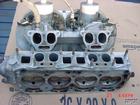
Dual valve springs, GX cylinder head and intake
- 11041-H2302 A12 GX cylinder head (to 6/73)
- 11041-H5703 GX cylinder head (from 7/73) same specs, but for newer engine style
Nissan Competition called the newer head a "GX" head. But this appears to be the A12T head (11041-H5702).
NOTE: Dual valve springs alone is not an indication of the GX head. N10 A14E engines also used dual-springs, but were not large-port heads. Also over the years many heads have had dual springs added. For ID, check the intake port sizes.
For more details, see Main Article: A12GX Engine
A14 Round-port High-Swirl head
These have quench chambers (not open chambers) but instead of being used in high-compression engines, they are designed for high swirl (for better fuel economy and improved emissions). They are used with dished pistons. Unlike the swirl-port heads, these have unobstructed ports. The ports are lowered so that the charge is forced to swirl as it enters the chamber.
A12A/A14 Round-port head
Intake: 37mm
Exhaust: 30mm
Has round intake ports (like the A12 head). Casting numbers are under the valve cover area: "990" towards the rear and "454" towards the front. This is the head used on A12As and some A14s. These cannot be ported out to match the oval port heads (you'll hit a water jacket). These can be found on some late A14s, like 1980. It has two small coolant holes below the intake ports, to provide heat for the intake manifold. These came on the "GFU" and "MPG" cars (USA-market B210 and B310 fuel economy champion models).
A12A small-Oval Swirl-port head
Intake: 37mm
Exhaust: 30mm
Has an H95 cast into it, under the valve cover area, has what some call a "swirl" port has an obstruction cast into the port to cause the flow to swirl but it reduces total flow, If you look into the port, from the manifold side, you'll see a heavily shrouded port, almost half of the size, it would normally be, on an A14 head. If you try to grind out this obstruction, you will hit a water jacket and render the head useless. It too, has the coolant holes in it.
They also have a small but deep combustion chamber, hence a different dish in the piston.
A14 Oval-port "H72" head
Intake: 37mm
Exhaust: 30mm
Sometimes erroneously called the "low compression GX head", it has a casting number "H72". Has a larger 360-degree "open" combustion chamber for lower compression ratios. It does not have the coolant holes below the intake ports. The H72 head was common around 1977-1978. This H72 head is basically the same as the Nissan Competition Head, but it has a lower compression combustion chamber, and does not have the port and polish of the Competition Head. It has the nice straight big oval intake ports. It is better than the A15 oval "swirl port" head, and certainly better for high RPM use than the round intake port A14 heads. EGR port in the exhaust ports. These can be milled .080" or more to raise compression.
So is Oval-port "H72" a good head or not? [Naukkis] says the high-compression head is a better design, and not just because of the compression (see New A series oval port head). The quench design of the combustion chamber is more efficient. The best combo for low compression would undoubtedly be a high-compression head used with half-dished pistons (half-flat-top, half dish), but are these available for the A-type engines?
Competition Head
Intake: 35mm (optional 37mm)
Exhaust: 29mm (optional 30mm)
The Competition Head has the large oval ports and a small heart-shaped chamber and was available from Datsun Competition, later called Nissan Competition and then Nismo. The part is unforunately now NLA (No Longer Available). This race cylinder head reported has the same 29 cc chamber volume as the A12GX head.
Sometimes the Competition Head is erroneously called the A14 "GX" head because it has the A14 size valves, but is more accurately described as a ported and polished version of the standard A14 high-compression head.
- 99996-H1167 Competition Cylinder Head (to 6/73)
- 99996-H1165 Competition Cylinder Head (from 6/74)
The Competition heads are "recommended for racing purposes only ... ported, polished ... competition intake (37 mm)... competition exhaust (30 mm)" -- in other words, the same valve sizes as regular A14 heads. However, the valves are tulip-machined for better flow.
Presumably the difference in the two Competition Head part numbers only differ in the oil passage and fittings/bolt holes.
Other heads
Anyone have more information on these?
- There is apparently an A14 Oval Port "GX" head which flows more than the A12GX head. reference: GX Head or A15
- An A15 "GX" head was used by Nissan for racing. There are several different chamber shapes and sizes but just the improved flow though the oval ports is better than the stock round ones. The valve sizes should be larger and some were fitted with dual valve springs.
Measuring Combustion Chamber Volume
Here's what you need:
- A large syringe marked in CCs (without the needle, or remove the needle).
- a piece of plexiglas, big enough to cover one cylinder. Drill a small hole about 6mm from edge of the plexiglas
- some grease
Syringes are available from animal feed stores or your local chemist. Get a couple of syringes one thats about 20mls and one that has 0.1 increments which is normally about 3mls. That will cost $1-$2.
Here's how to measure:
- place the head upside down as level as possible
- put a small ring of grease around one of the combusion chambers
- place the plexiglas over it and press it flat
- Fill the syringe with water, and measure how many CCs it takes to fill the chamber
This is also a good way to tell if the valves are sealing well. It should hold water for several hours with no visible leak. If the water leaks out, it's time to lap the valves!
Note that pistons came with different dishes according to year, country, etc.
Which Cylinder Head is "Best"?
The two main factors for peak horsepower:
- combustion chamber design: closed chamber "heart-shaped" is more efficient than open chamber
- port flow: oval is better than round for high-rpm use, and larger valves can be useful
NOTE: Don't confuse "open chamber" for a hemi-style chamber. Yes, both are 360-degree 'open', but the term "hemi" refers to valves at 45-degrees to each other (all A-type engines use valves parallel to each other). The "open" chamber is not inherently better flowing, but is used to reduce compression for lower NOx emissions.
Some say to start with the A12GX Engine head due to its high-compression chamber. Adding bigger valves is good for high-rpm power. Others say a ported standard A12 head will flow as much as the A12GX, but this doesn't increase the compression.
GX heads are not always easy to find, though they pop up for sale every year.
"The best head of the easily available variety, IMO is the H89 head from the A15." - A14Force.
Or you could use the H72 head, and shave/mill it to increase compression.
The A14GX (high-compression) head is probably the best all-around head: big valves, big ports and an efficient chamber design. But you probably cannot find this Competition head ... unless you already have one.
Aftermarket piston styles vary (flat-top or dished, and aftermarket popup/domed pistons). With dished pistons, the pistons can be shaved and the block milled (up to 0.090 inch) to make high compression "flat-top pistons".
On the other hand, for a supercharged motor low compression is best, because you can use more boost and gain more power than is lost due to the low compression.
- closed chamber head with a half-dished piston is probably best due to the efficient "quench" combustion
For a low-rpm 'grunt' engine, or for maximum fuel economy, you'll want:
- Small ports
- large valves with an A14 or A15, small stock-size valves with an A10 or A12 (anyone have another opinion?)
- closed chamber or swirl-port head
So which is better for a street engine?
- High compression engine: pay 15% premium for high-test fuel but get better mpg
- Low compresion engine: buy the inexpensive petrol, but get worse mpg
Modifying a Head
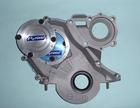
Timing Cover for variable cam gear
Port and Polish
See: Head Porting
Part Numbers
See Cylinder Head Part Numbers
DOHC Heads for A-series
See DOHC Heads

![[Datsun 1200 encyclopedia]](/wiki/upload/wiki.png)
